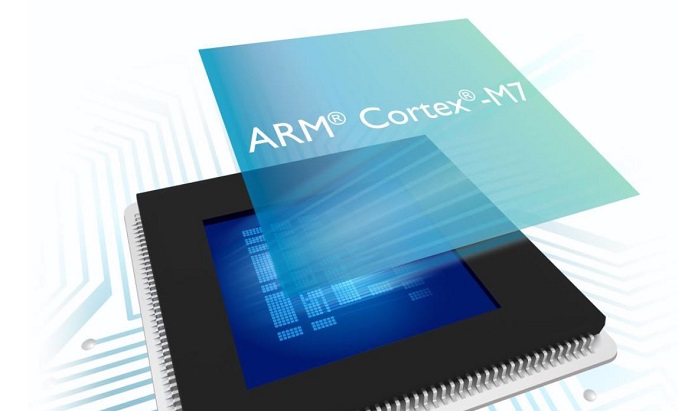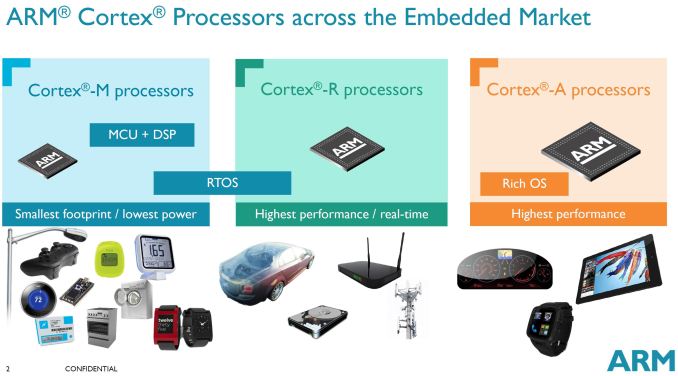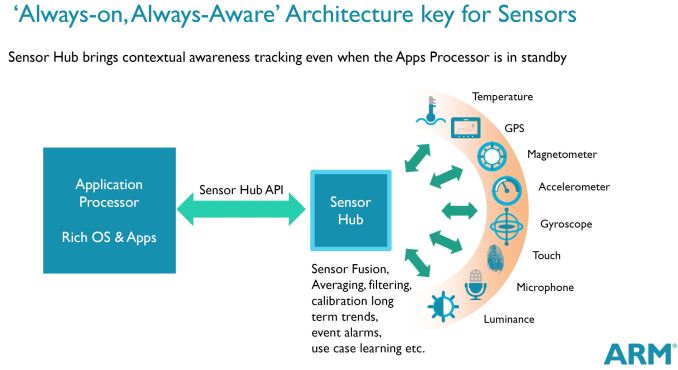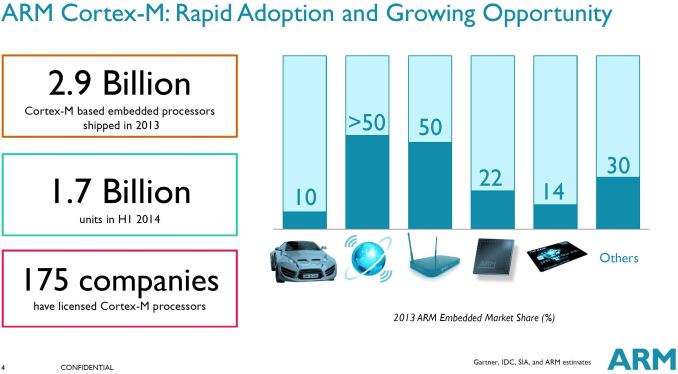Cortex-M7 Launches: Embedded, IoT and Wearables
by Stephen Barrett on September 23, 2014 7:01 PM EST
Introduction
Last week, I had the distinct pleasure of visiting ARM’s Austin Texas campus for a meeting with Vice President of CPU Product Marketing Nandan Nayampally. The topic of discussion: ARM’s next Cortex-M processor, codename Pelican, is officially launching today as the Cortex-M7. Thankfully, unlike the A series CPU cores mobile device enthusiasts have grown to love, M and R series cores are typically announced at the same time as retail availability from ARM’s customers. ARM has therefore been working with lead semiconductor partners for some time, and their fully integrated products should have similar launch announcements soon.
If you are not familiar with the M and R series processors from ARM, I don’t blame you. These microcontroller processors don’t receive quite the coverage as A series application processors like the A7, A9, A15, A53 and A57 do. Considering my own heritage learning about PC technology, this is understandable. I always wanted to learn about the latest processors from AMD and Intel as these most directly related to my productivity and entertainment. However, if the smartphone wave was any indication, the next decade of productivity and entertainment might come from processors we don’t expect or even know about.
Fundamentally, the M series processors are considered microcontrollers and not application processors, mainly because they lack a memory management unit (MMU). An MMU’s primary role is to sit between the processor and memory, intercepting all memory references and performing translation between virtual addresses and physical addresses. General purpose operating systems such as Linux (Android), Windows, OSX, and iOS require an MMU to function. That means M series processors, like all microcontrollers (MCUs), will never be tasked with running general purpose operating systems.
MCU proliferation is actually already happening today. Nandan mentioned that a device containing a single R or A series processor might also contain dozens of Cortex-M processors performing a variety of tasks that make your life better. Nandan couldn’t mention any specific implementations, as he deferred to ARM's customer’s for that, but everything from smart thermostats, simple smart watches like the Pebble, and IC power management units are implemented with low power microcontrollers.
Even features we love on our high powered smartphones such as Microsoft’s Lumia Glance Screen and SensorCore, Motorola’s Moto Voice and Moto Display, and the iPhone’s Motion Coprocessor cannot be directly attributed to bigger faster application processors but rather come from MCUs, and arguably they have just as big an impact on our lives as a lower Sunspider score.
Looking at ARM’s track record in the past five years, one can easily correlate their success with the smartphone craze started with the original iPhone containing an ARM11 processor. From there, the 3GS upgraded to a Cortex-A8, 4S used the Cortex-A9, and Google attacked the same market with Android supporting the ARM11 and subsequent ARM cores as well. While ARM’s meteoric rise might have started with the ARM11, it was years of prior work that provided a solid foundation for partners and customers. In fact there were 11 cores released prior to the ARM11 (fancy that), including six revisions to their instruction set.
ARM has been investing in the Cortex-M line since 2004, when they first released the Cortex-M3. For a decade, ARM has been combating 8-bit and 16-bit microcontrollers with their 32-bit M series. With the release of the M7, ARM feels they have a very complete microcontroller lineup and have effectively “crossed the chasm” into the mainstream. The competition continues today, but with eight billion (yes, with a b) processors shipped to date containing at least one Cortex-M core, the M series is higher volume than all other ARM cores combined. In the first half of this year alone, ARM’s partners have shipped 1.7 billion Cortex-M units, where a unit is defined as a chip containing at least one Cortex-M processor.
Responding to market demand for powerful voice, sensor, display, and control offloading, ARM brings a higher performance, feature rich core to the Cortex-M family with the M7.













43 Comments
View All Comments
Stephen Barrett - Tuesday, September 23, 2014 - link
ARM specifically advised against comparing performance numbers across architectures, saying it was an apples and oranges comparison.Despite similar numbers in these very synthetic benchmarks, when running actual application code , the M7 will never compete with the A series. The numbers are only useful comparing within the family.
Wilco1 - Wednesday, September 24, 2014 - link
Sure an M7 will never run Android, but that's not the point. v7-M and v7-A share the same Thumb-2 ISA and use the same compiler backend, so it's not apples/oranges. You can run the same binary on an M7 and A7 if you wish.Due to its shorter pipeline, an M7 should beat an equivalently clocked A7. Of course an A7 can clock 2 times as high in 28nm so it wins in absolute performance. However that still means M7 is a huge leap from an M3/M4.
tuxRoller - Wednesday, September 24, 2014 - link
The chart says 2.14-3.23 dmips/mhz, or 5.04 coremark/mhz, so atom d525 or core i5-2400 for coremark, or between intel pentium/pentium pro and pentium 3.http://www.eembc.org/coremark/index.php
https://en.wikipedia.org/wiki/Instructions_per_sec...
Flunk - Thursday, September 25, 2014 - link
Intel Quark.KlausWalter - Wednesday, September 24, 2014 - link
For those guys who understand german here is the best review so far including the first implementation of the Cortex-M7 in a real MCU, a so called STM32F7 Family delivered by ST Microelectronics: http://www.elektroniknet.de/halbleiter/mikrocontro... Google translator may help....uningenieromas - Wednesday, September 24, 2014 - link
The three big guys in the MCU world (Atmel, Freescale and ST) are already working in Cortex M7 processors and I'm sure they already have a internal implementation of the MCUs:http://www.arm.com/about/newsroom/arm-supercharges...
Freescale has it already in it's roadmap, and it's called Kinetis X.
jdesbonnet - Wednesday, September 24, 2014 - link
Microchip is also a 'big guy' but is conspicuously absent from the ARM party. Which is a pity: I like their stuff, but I've now standardized on the ARM Cortex-M family of MCU.ah06 - Wednesday, September 24, 2014 - link
So we expect to see this as the core of an SoC in wearables and for high end wearables, ARM recommends a gimped A7. Well what about the R series that falls right in between?I'm still very fuzzy on the relative comparisons between the wearable processors. Maybe do an article comparing Aster platform (ARM7ESJ), Cortex-M4/M7, Cortex-Rx, Cortex-A7/A53
Thanks
FunBunny2 - Wednesday, September 24, 2014 - link
-- the M series processors are considered microcontrollers and not application processors, mainly because they lack a memory management unit (MMU).Well, then, the X86 wasn't a real cpu, because the MMU was off chip for rather a while. Not until the 386 was it really implemented.
hammer256 - Wednesday, September 24, 2014 - link
So what are the target market of the M series and R series? R series is higher performance? Both lack MMU right? The distinction between the two lines are kinda blurry to me.